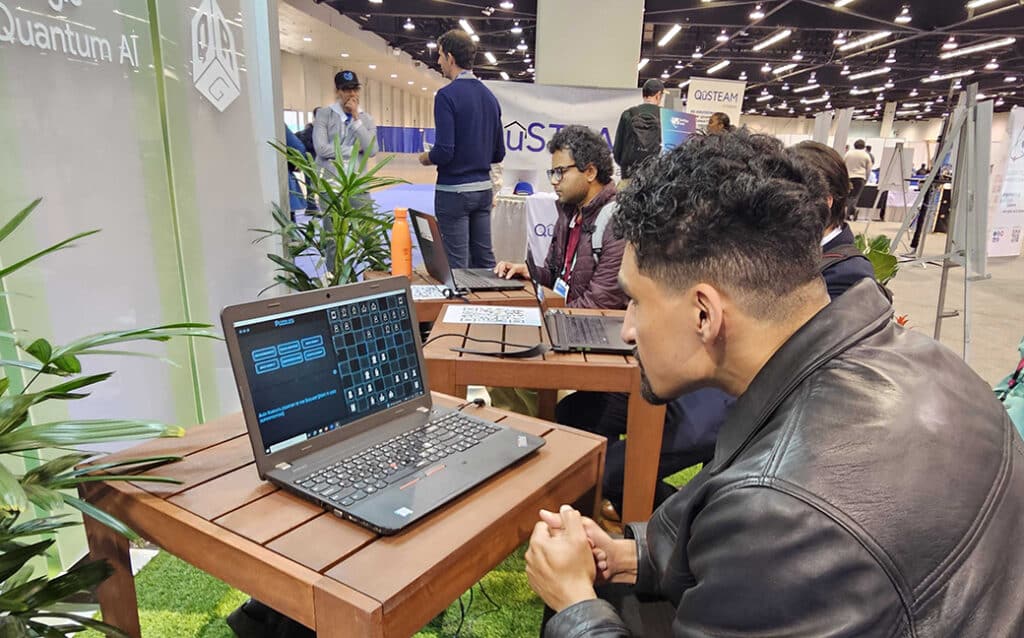The Q2B show in Santa Clara last week ended with an amazing session with some of the top quantum hardware heavyweights gathered on a panel to discuss their platforms and the path to fault-tolerant quantum computing.
Moderated by Yuval Boger, the session, titled The State of Logical Qubits, How Far Are We, How Are We Making These?, featured some of the leading lights in the industry, including Dave Landhuis, Quantum Fleet Engineering Lead, Google Quantum AI; Dr. Théau Peronnin, CEO & Co founder, Alice & Bob; Russell Stutz, Director, Commercial Hardware, Quantinuum; Mercedes Gimeno-Segovia, VP System Architecture, PsiQuantum.
Session attendees were attentive to every word as the panel sat under the bright lights of the stage while a NY Times reporter sitting behind me recorded the proceedings.
Why the buzz around this particular Q2B session? People are interested in how soon the Near-Term Intermediate Scale Quantum (NISQ) era may end and the Fault-Tolerant Quantum Computing (FTQC) era may begin.
This panel lineup would have valid opinions. Google was developing superconducting-based quantum hardware earlier than almost any company and shook the world with its ‘quantum supremacy’ paper in 2019. With its trapped ion hardware roots at Honeywell, Quantinuum did its own world-shaking last May with its topological qubits announcement. PsiQuantum, a longtime Bay Area ‘stealth’ quantum startup, is making huge investments in scaling its photonic-based system. And as the industry’s newer entry, French company Alice & Bob’s ‘cat qubit’ approach could very well accelerate the race to FTQC success.
Well-known in the industry for The Superposition Guy podcast, Yuval served a dual role onstage as Chief Marketing Officer for QuEra, which also made noise itself last week with its announcement of achieving an incredible 48 logical qubits.
As a longtime fan of The Right Stuff (both movie and book), it felt a bit like a reprise of the press conference with the Mercury astronauts, especially when Yuval asked the panel when each company believed they would achieve ‘usable error correction,’ echoing the “Who will be first in space?” from the early 1960s space era.
Most of the panelists declined to provide a specific timeline, but all seemed in agreement on one aspect — the industry had passed the point of ‘if’ effective error correction will be achieved and advanced to ‘when.’
The conversation was congenial with occasional differences of opinion expressed in respectful tones. Questions and answers ranged from why a particular modality will succeed, to the challenges of a particular modality, to the ‘lag time’ between research and customer availability.
There was good humor as well. When asked if keeping cat qubits “alive” was a challenge, Théau of Alice & Bob responded that “no cats were harmed” in the making of the company’s signature technology.
But the real question on everyone’s mind is when will quantum computers have enough error correction to deliver computational value beyond classical computing. A snippet of each panelist’s answer follows:
Dave of Google Quantum AI: The only future date that I’m going to talk about is the date of the immediate next milestone. And we think it’s going to take us at least until 2025 to make the long-lived logical qubit.
Russell of Quantinuum: When I started seven years ago on the Honeywell commercial quantum computing effort, it was more ‘if’ and now I think it is ‘when.’ I think we’re approaching it from a lot of different angles and it’s a very interesting race, but I will decline to put exact dates on where we’re going to be.
Théau of Alice & Bob: We’re definitely in this interface moment going from NISQ to FTQC. It’s hard now to argue that FTQC won’t happen. I’ll argue you it would be really nice to have somewhere between 50 to 100 logical qubits with 10-6 error rate. And hopefully this should happen before the end of the decade.
Mercedes of PsiQuantum: While also declining to provide a specific date, Mercedes pointed to company announcements regarding system power and photonic interconnect developments that “give you an idea of the scale of the systems we’re working towards. And maybe, given the things that are being manufactured now, it gives you an idea that we’re very serious about doing this in a very short time scale.”
Yuval of QuEra: If you asked me that question yesterday, I don’t know what I would have said, but this morning one of our scientific co-founders had this last slide and said in two years we’re going to have 100 qubits of 10-6 to 10-8.
The industry, and the world, will have to watch, wait, and see.




